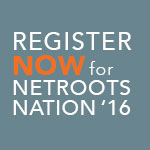After a great run, the Winning the Internet blog has been retired. However, you can still keep in touch with New Media Mentors here.
As we get ready for Netroots Nation 2014, we’re taking a closer look at some of the convention’s most exciting training sessions. We’re interviewing the trainers and taking you inside some of online activism’s most popular and elusive topics.
Today we’re interviewing Josh Berezin of Analyst Institute, who’ll be leading Field-tested best practices for GOTV in 2014.
NN14 Training Session
Field-tested best practices for GOTV in 2014
Over the last few years, the use of GOTV best practices derived from academic and private research have become standard on many campaigns, but we’re learning more every cycle. In this presentation, we will review the principles behind GOTV best practices that allow campaigns to generate more ballots cast per voter contact. We’ll also cover a handful of the latest findings that came out of 2012, and then preview the upcoming research topics of the 2014 cycle.
Interview
Q: Tell us about yourself and your experience with GOTV and GOTV research.
A: I worked on field-heavy campaigns in Oregon starting in 2004, curious from the get-go about what worked and what didn’t, and the comparative effects of different voter contact programs.
As soon as Analyst Institute came into existence, I started bringing them into the state to attach research to our programs. In 2011, I joined up with Analyst Institute as a staffer to help conduct randomized controlled experiments in partnership with campaigns and organizations around the country. At Analyst Institute, I’ve been able to tap into a huge body of existing GOTV research and direct new research to help fill the gaps in our collective knowledge.
Q: In your opinion, what is the most common mistake that organizations make when doing GOTV work?
A: There’s a organizational tendency to chase the same targets and the same races that other groups are targeting. Directing resources to geographies or targets others have ignored, or investing in elections other than November general elections, could have a large impact.
Q: What are the two most important things to keep in mind when doing GOTV work?
A: While it’s well-known at this point that high-quality voter contact is a two-way conversation, not just a one-way delivery of information, the content of that dialogue is critical to its impact. Using tested psychological principles in your conversation turns a good voter contact into an effective voter contact.
We don’t reveal our results to just anyone, which is why I’m not listing specific techniques here. But I will be sharing many in the session.
(cue dramatic secret agent music…)
Q: Why should folks attend your session at Netroots Nation?
A: The reason we all do this work is to make an impact. When I’m contacting voters, I always want to be equipped with the most-effective language available. I’m thrilled to be able to share findings that can make the good work we all do even more powerful.
To attend this training, or one of the 39 others at Netroots Nation 2014 in Detroit, register now.




Trackbacks/Pingbacks
[…] By Melissa Foley […]